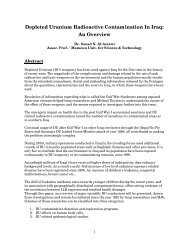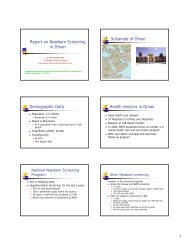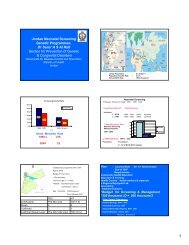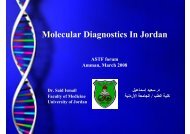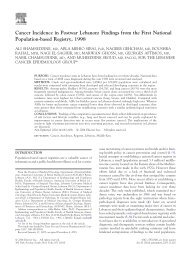Genetic disorders - Jeans4genes.org
Genetic disorders - Jeans4genes.org
Genetic disorders - Jeans4genes.org
You also want an ePaper? Increase the reach of your titles
YUMPU automatically turns print PDFs into web optimized ePapers that Google loves.
64 CARING FOR ARAB PATIENTSthe female partner, the lower the consanguinity rate. 11 On the contrary, in somesocieties, highly educated men are more likely to be married to cousins. 33 Aplausible explanation is that since a son with higher education becomes a morevaluable asset, he is pressured to remain within the family. 11While a declining trend of consanguineous marriages has been documentedin Bahrain, Lebanon, Kuwait and Syria, a stable trend has been reported inJordan and Oman. 33 However, these rates have increased over the last generationin Algeria, 36 the UAE 37 and Yemen. 33 The reason for the rising trend inconsanguinity has been attributed to the increase in the availability of cousinsdue to high fertility. 33Consanguinity and reproductive healthWhile the concept of inheritance is not clear in the minds of many lay people,consanguinity is linked to high incidences of congenital malformations, mentalretardation and disability. Studies indicate that in populations where the practiceof inbred marriages is high, the frequency of homozygosity for autosomal conditionsand the incidence of congenital anomalies, abortions, stillbirths and earlychildhood deaths are likely to rise. 3,38 The reason behind this observation is thatthe more closely two people are related, the more genes they share. A marriagebetween first cousins increases the risk of having a child with a severe congenitalor genetic disorder by 2.5 times since parents share one-eighth of their genes. Anaverage of 30% first cousin marriages in a population would increase the birthprevalence of many conditions by 5–15 times and their collective frequency by5.5 times. Frequent consanguineous marriage increases the incidence of autosomalrecessive <strong>disorders</strong> by 5–10 times at the population level. When first cousinmarriage is considered, the risk of recessively inherited <strong>disorders</strong> is multipliedby 15–30 times; hence, there is a doubling of the total frequency of congenitaland genetic <strong>disorders</strong>. 39While the incidence of recessively inherited <strong>disorders</strong> increases with theincreasing trend of consanguineous marriages, consanguinity has no effecton the frequency of autosomal dominant or X-linked conditions. Autosomaldominant conditions result from just one copy of a deleterious mutation. Thus,having two parents with the same autosomal dominant mutation does not makean individual more susceptible than someone with only one affected parent.Similarly, just one copy of a deleterious X-linked recessive mutation will resultin disease in males. Hence, having related parents does not increase the risk ofa male with X-linked recessive disease.Recently, many studies from the region have drawn strong correlationsbetween consanguinity and hearing loss, 40 death rates in children, 41 respiratoryallergies, eczema, 42 congenital heart defects, 43 mental retardation, epilepsy,diabetes 44 and many other conditions. 1,2



